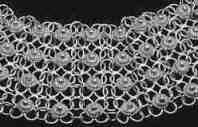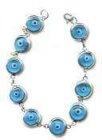 The bracelet is a very ancient form of human adornment, and the designs of the earliest surviving examples suggest that, like so many other types of jewelry, they were originally a form of talisman or magic charm. The first bracelets were made of wood, stone, and soft metals occurring naturally in their metallic state, primarily gold and copper. As technology developed over the millennia it became possible to extract and work silver and other metals. Today bracelets are as popular as ever. Stylistically they fall into two categories, what we might call the classical imitating old forms, and modern designs in abstract and original styles.
The bracelet is a very ancient form of human adornment, and the designs of the earliest surviving examples suggest that, like so many other types of jewelry, they were originally a form of talisman or magic charm. The first bracelets were made of wood, stone, and soft metals occurring naturally in their metallic state, primarily gold and copper. As technology developed over the millennia it became possible to extract and work silver and other metals. Today bracelets are as popular as ever. Stylistically they fall into two categories, what we might call the classical imitating old forms, and modern designs in abstract and original styles.
All women, from the queen in her palace to the rural woman in her cottage, whatever their income or cultural level, have always enjoyed wearing bracelets. But apart from their decorative qualities, bracelets have had other functions. For example, copper bracelets are still believed to relieve pains in the joints, and in former times bracelets containing agate, a stone regarded as sacred amongst the Turks were believed to protect the weaver against bites by venomous animals. Bloodstones, meanwhile, were believed to stop bleeding.
Gold bracelets studded with precious stones were preferred by the wealthy, but silver was also used to make some of the finest bracelets in which the colored stones showed up against the white metal to wonderful effect. Silver puts up with the forging process with all the patience of a dervish suffering oppression and deprivation. When red hot it is drawn out into wire, or placed on a bed of pitch and designs hammered into the surface. Studded with stones, patterns chiseled out for niello designs, gold plated using mercury, or decorated with tiny silver drops to produce the jeweled effect known as Güverse, the bracelet completes its trial by fire on the forge and is ready to encircle the wrist of a loved one.
A wide range of other techniques are used to make or decorate silver bracelets. One of the loveliest is filigree, and similar types woven with circular or flat silver wire. Another is engraving. Often two or more techniques are combined in a single bracelet, and some techniques are associated with the place where they are commonly made, such as Trabzon Hasiri - a type of filigree bracelet, Kayseri Burmasi and Halep isi.
 Although in the past hundreds of different types of bracelet were made, often the same craftsman making several types or developing innovations of his own, relatively few antique Turkish bracelets have survived. Even the names by which they were known are often not remembered today. As well as types known after the cities where they were most commonly made, there were names describing the forms, such as kabara (boss), kubbeli (domed), zincirli (chain), koruklu and tankli (also known as bascavus) bracelets.
Although in the past hundreds of different types of bracelet were made, often the same craftsman making several types or developing innovations of his own, relatively few antique Turkish bracelets have survived. Even the names by which they were known are often not remembered today. As well as types known after the cities where they were most commonly made, there were names describing the forms, such as kabara (boss), kubbeli (domed), zincirli (chain), koruklu and tankli (also known as bascavus) bracelets.
Bracelets worn around the ankle are called halhal, an Arabic word meaning ankle. These are worn in many countries from Africa to India, including the eastern and southeast parts of Turkey. Traditionally halhal were made from a string of hollow spheres containing tiny metal beads, so that they made a pleasant tinkling sound as well as looking attractive. Rural women used to their children so that when they were busy working in the fields and orchards they could hear where they were playing even when they were out of sight, and would be warned by the sound if they strayed off.
Today, there are many decorative bracelets made with Nazar Bonjuk beads as well.

